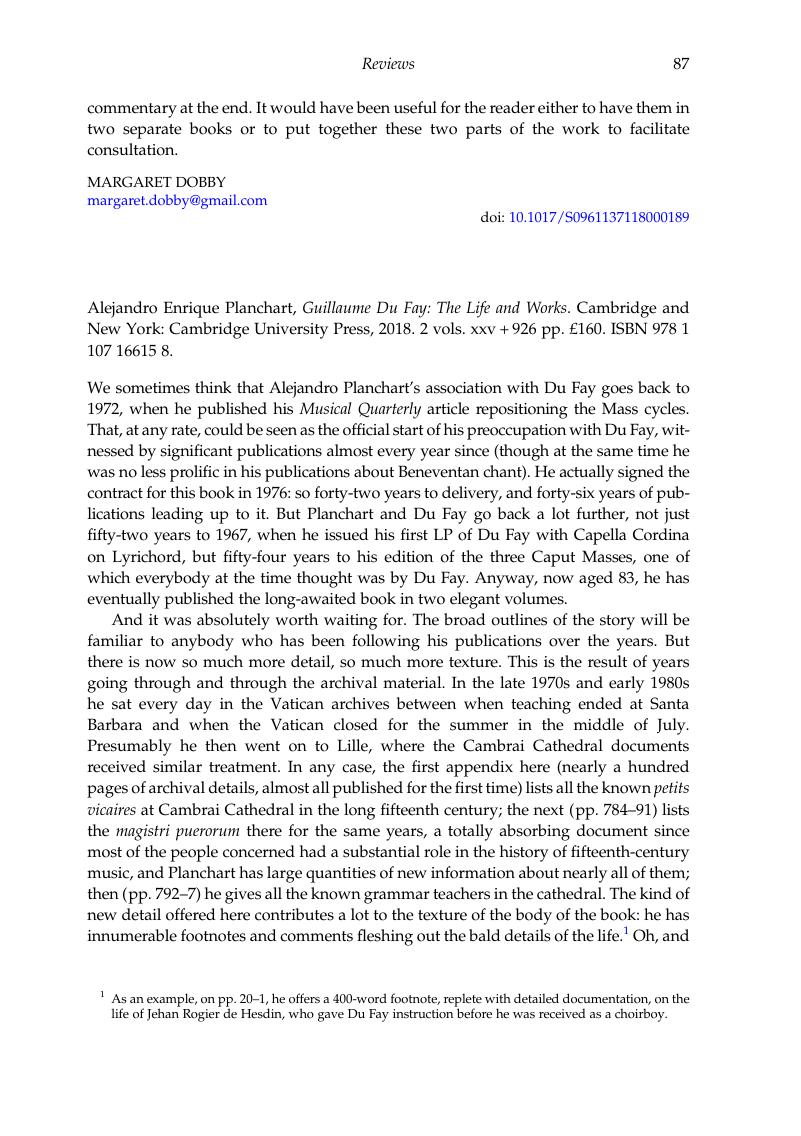No CrossRef data available.
Article contents
Alejandro Enrique Planchart, Guillaume Du Fay: The Life and Works. Cambridge and New York: Cambridge University Press, 2018. 2 vols. xxv + 926 pp. £160. ISBN 978 1 107 16615 8.
Published online by Cambridge University Press: 09 April 2019
Abstract

- Type
- Reviews
- Information
- Copyright
- Copyright © Cambridge University Press, 2019
References
1 As an example, on pp. 20–1, he offers a 400-word footnote, replete with detailed documentation, on the life of Jehan Rogier de Hesdin, who gave Du Fay instruction before he was received as a choirboy.
2 Concerning these last two, I would particularly draw attention to the material in chapter 13, where he goes to work on all those Mass Proper movements in Trento 88, only three of which show any surface evidence of being by Du Fay. With unbelievable care he goes through the liturgical issues, the chant variants in various churches, the likely corruptions that could arise from Wiser's own liturgical knowledge and much else. This is virtuoso reasoning.
3 Planchart, Alejandro Enrique, ‘Guillaume Du Fay's Benefices and his Relationship to the Court of Burgundy’, Early Music History, 8 (1988), 117–71Google Scholar, at pp. 121–3.
4 As first hinted in Wright, Craig, ‘Dufay at Cambrai: Discoveries and Revisions’, Journal of the American Musicological Society, 28 (1975), 175–229CrossRefGoogle Scholar, at p. 175.
5 In fact, Planchart reports (p. 86) a document of 1427 at St-Géry in Cambrai denying him his revenues as a chaplain on the grounds that he was not yet a priest. That seems to me a good enough reason for his having obtained ordination in that year.
6 Intriguingly, Planchart reports (p. 19) that Du Fay became a choirboy in Cambrai Cathedral in the week beginning 5 August 1409. Given that even his tombstone mentions that he was ‘in huius ecclesie chorialis’, that event evidently had some significance for him.
7 Planchart, Alejandro Enrique, ‘Notes on Guillaume Du Fay's Last Works’, The Journal of Musicology, 13 (1995), 55–72CrossRefGoogle Scholar, at pp. 65–8.
8 Planchart, ‘Guillaume Du Fay's Benefices’, p. 119, n. 11.
9 First proposed in Planchart, Alejandro Enrique, ‘The Early Career of Guillaume Du Fay’, Journal of the American Musicological Society, 46 (1993), 341–68CrossRefGoogle Scholar, at pp. 357–60.
10 Robertson, Anne Walters, ‘The Man with the Pale Face, the Shroud, and Du Fay's Missa Se la face ay pale’, The Journal of Musicology, 27 (2010), 377–434CrossRefGoogle Scholar, at p. 419, n. 91.
11 Ibid., p. 426.
12 Pibiri, Eva, ‘L'acquisition du Saint Suaire par la maison de Savoie en 1453: des nouveaux textes’, Rivista di Storia della chiesa in Italia, 57 (2003), 155–63Google Scholar, at p. 161. (Incidentally, the first document reference Planchart gives as fols. 351v–325r is obviously a misprint: it is given correctly by Pibiri as 351v–352r.) Since the abbreviated title of the other relevant work is not filled out in the bibliography, I provide it here: Deonna, Waldemar, Les arts à Genève des origines à la fin du XVIIIe siècle (Geneva, 1942)Google Scholar.
13 Planchart, Alejandro Enrique, ‘The Origins and Early History of L'homme armé’, The Journal of Musicology, 20 (2003), 305–57CrossRefGoogle Scholar, at pp. 317–23. In the book under review, the ascription is discussed on pp. 273–4 and 661–2; elsewhere it is treated as fact.
14 Fallows, David, Henry V and the Earliest English Carols (London, 2018), 43–51Google Scholar.




